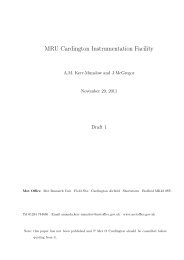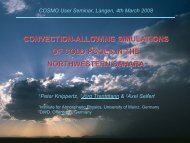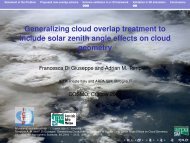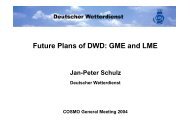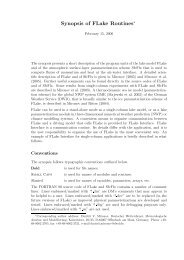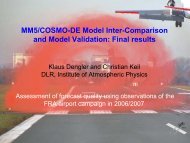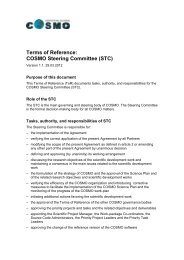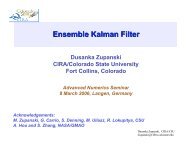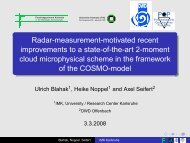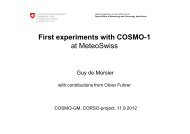document - Cosmo
document - Cosmo
document - Cosmo
Create successful ePaper yourself
Turn your PDF publications into a flip-book with our unique Google optimized e-Paper software.
1 Working Group on Data Assimilation 39<br />
In strongly stable situations and in particular at inversions, model errors are known to be<br />
increased often. In the revised QC for LM, the assumed background error σb is therefore<br />
enhanced by 2 terms selectively for those humidity observations at which the observed lapse<br />
rate β to the next humidity observation further above or below is β > βcrit = −0.0065 K/m :<br />
σb → σb · (1 + fstable + finvers)<br />
fstable = 1/4 · (1 − min(β, 0) / βcrit) · (1 + cs) , cs = ∆βT/(1 + ∆βT )<br />
finvers = 1/5 · max( ∆T , 0 ) · (1 + ci) , ci = min( 2 , β / 0.05 )<br />
∆T = Tk − Tk−1 , where Tk and Tk−1 are the temperature observations at the humidity<br />
observation level k respectively at the next level k−1 further below. ∆βT = T β<br />
k − Tk−1 ,<br />
where T β<br />
k is Tk extrapolated to level k−1 with the lapse rate βcrit . Both terms fstable<br />
and finvers increase with increasing stability and with increasing thickness of the stable<br />
layer (given by the two successive humidity observation levels).<br />
Finally, an upper limit of 70 % is imposed to the threshold Uthr (to) at observation time.<br />
With increasing distance to the observation time, the threshold is enhanced linearly to a<br />
maximum of 77 % (with the temporal weight function used currently in the nudging).<br />
Multi-level check<br />
The revised multi-level check is analogous to that of the GME OI analysis (but not equivalent,<br />
due to the different, stability-dependent thresholds for flag ≥ 1 in the first guess check):<br />
• Analysis layers are defined equal to the standard layers except below 700 hPa , where<br />
the thickness of the analysis layers is reduced to 50 hPa and below 800 hPa to 25 hPa .<br />
• Criterion: If 4 or all consecutive standard layers contain humidity observations with<br />
flag ≥ 1 , then these standard layers are set to ’rejected’. Each analysis layer within<br />
those rejected standard layers is set to ’rejected’ if it contains observations with flag<br />
≥ 1 . All observations within these rejected analysis layers are rejected.<br />
Spatial consistency check of integrated water vapour (IWV)<br />
A spatial consistency check of integrated water vapour has been developed to detect a general<br />
bias in a radiosonde humidity sounding. As a first step, observation increments of IWV are<br />
derived from radiosonde humidity profiles and optionally also from ground-based GPS zenith<br />
path delay data. At the location of each IWV ’observation’ Qk , an IWV ’analysis increment’<br />
∆Q ai k is then computed using only the neighbouring observations Qj�=k :<br />
∆Q ai k =<br />
�<br />
j�=k<br />
w 2<br />
kj · Qsat (xk,t)<br />
Qsat (xj,t) · ( Qj − Q(xj, t) )<br />
�� �<br />
max j�=k w 2<br />
kj , 1<br />
Here, Q sat (xk, t) is the IWV derived from the model temperature profile at the observation<br />
location assuming saturation. The Q sat term scales the observation increment, mainly<br />
in order to account for differences in orographic height. The weight wkj consists of a<br />
horizontal weight (equal to that used for the nudging of radiosonde humidity data at 850 hPa<br />
respectively for GPS data), and of a temporal weight (given by a linear function of time within<br />
± 2 h respectively ± 1 h from the observation time).<br />
COSMO Newsletter No. 6




